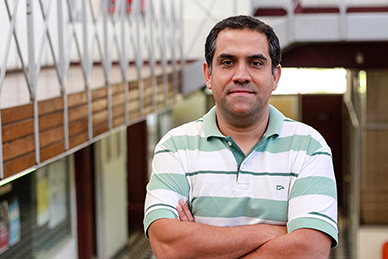- According to Scopus database, the most cited article of Universidad de Santiago during 2012 belongs to Mario Inostroza, of the Department of Informatics Engineering, who is part of an interdisciplinary team of Australia that has provided findings related to different organisms’ genomes and has developed computational biology studies.
In 2012, Universidad de Santiago de Chile published 421 scientific articles, according to Scopus database. Out of these articles, the most cited one was the article written by Mario Inostroza, PhD, a researcher at the Department of Informatics Engineering, of the Faculty of Engineering. This result included 2012 and the record was closed on November 28th, 2013.
The work called “Genome-wide analysis of long noncoding RNA stability”, was published on the American journal Genome Research (Q1), and gives information about new findings regarding different organisms’ genomes and about computational biology studies, among others.
For the author, an expert in Computer Science, “being cited by the scientific community is recognition of the research work that I am doing. My goals are to continue working on this research line and to contribute, from Computer Science, to new areas of development.”
This work is the result of an interdisciplinary collaboration work with research groups of Australia, where professor Inostroza contributed from his discipline. “My particular contribution has been from the world of Computer Science and the development of data analysis advanced tools,” Inostroza said.
The results show new evidence of how some DNA sequences work, that before were considered only as noncoding DNA. “Particularly, we found a stable behavior in a large group of these sequences, that shows that they may have an important role in complex metabolisms and different functions,” he explained.
For the academic, besides being a purely scientific contribution, this work is also important because it reflects the spirit of the Department of Informatics Engineering, where the knowledge of Computer Science is applied to different areas, collaborating with top-quality research groups.
Quality versus quantity
An issue that is constantly debated among the scientific community is that, when it comes to publishing articles, a researcher should favor quantity or quality. Regarding this, Dr. Inostroza said that an article goes under several proof procedures, what in turn results in a good-quality and good-level article.
First the researcher’s work is studied. He has to comply with all the steps demanded by scientific rigor. Then, the article undergoes a revision process by the corresponding journal or conference committee. In the end, the scientific community is the one that judges the article’s quality by citing it or using its results.
“During the last years, what has been mainly judged is the number of publications that a researcher has, acknowledging and considering the ones with a larger number of publications. The nature of the different research areas has long been discussed and the number of publications in each considerably varies. I believe that a differentiated acknowledgement policy according to the research area would positively contribute to improve the quality and the impact of the works presented,” Inostroza said.
Regarding to what the University should promote in this area, professor Inostroza has a clear opinion: “Together with encouraging teachers to do research and publish articles in high-impact journals, the University should strengthen collaborative work and the generation of networks with high-level international institutions and research groups. This will benefit not only the researcher. It will make possible the visit of renowned researchers and the exchange of undergraduate and graduate students.”
Finally, the academic suggested the need of protecting quality over quantity regarding the scientific production of the institution. “Nowadays, most of the University’s incentives are short-term (for example, number of publications in a year) and I don’t have information about long-term approaches. One example of this is the process called Evaluación de Antecedentes de Investigación (Research Background Evaluation) and the Asignación de Estímulo a la Excelencia en Investigación (Incentives for Excellence at Research), which consider the number of publications and not the impact that they have had.”
Translated by Marcela Contreras



